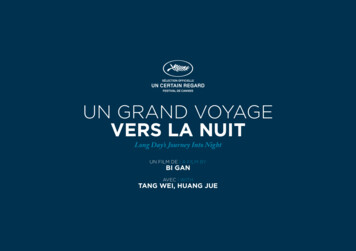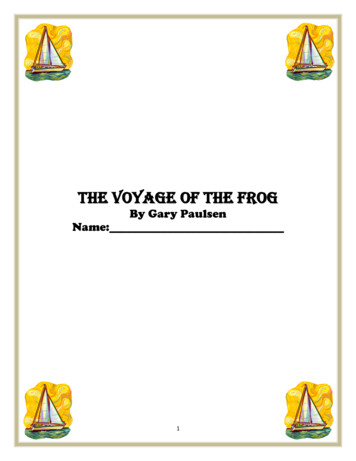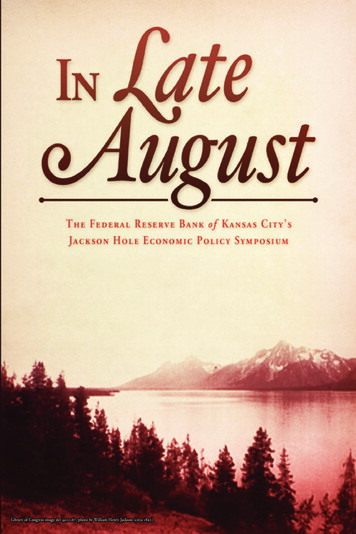
Transcription
UN GRAND VOYAGEVERS LA NUITLong Day’s Journey Into NightUN FILM DE A FILM BYBI GANAVEC WITHTANG WEI, HUANG JUE
DISTRIBUTION FRANCEBAC Films9, rue Pierre Dupont75010 ParisTél. : 01 80 49 10 00contact@bacfilms.frwww.bacfilms.comPRESSE FRANCEMonica Donati55, rue Traversière75012 ParisTél. : 01 43 07 55 22monica.donati@mk2.comBAC FILMS DISTRIBUTION etprésentent presentUN GRAND VOYAGEVERS LA NUITLong Day’s Journey Into NightDISTRIBUTION INTERNATIONALEINTERNATIONAL SALESParis65, rue de Dunkerque75009 ParisTél. : 01 43 13 21 15Cannes5, square Mérimée – 1st floor – CannesTél. : 00 33 (0)4 93 68 73 53Eva DIEDERIX – ediederix@wildbunch.euSilvia SIMONUTTI – ssimonutti@wildbunch.euOlivier BARBIER – obarbier@wildbunch.euFanny BEAUVILLE – fbeauville@wildbunch.euOlpha BEN SALAH – obensalah@wildbunch.euUN FILM DE A FILM BYBI GANAVEC WITHTANG WEI, HUANG JUEChine, France – 2018 – Durée : 2h13www.wildbunch.bizPRESSE INTERNATIONALEINTERNATIONAL PRESSRyan WernerCinetic MarketingMobile : 1 917 254 7653ryan@cineticmedia.comPhotos and press kit can be downloaded fromwww.bacfilms.com
SYNOPSISLuo Hongwu revient à Kaili, sa ville natale, après s’être enfui pendant plusieurs années.Il se met à la recherche de la femme qu’il a aimée et jamais effacée de sa mémoire.Elle disait s’appeler Wan Quiwen Luo Hongwu returns to Kaili, the hometown from which he fled several years ago.He begins the search for the woman he loved, and whom he has never been able to forget.She said her name was Wan Quiwen
HUITIÈME GÉNÉRATIONTHE EIGHTH GENERATIONJe dois beaucoup à Henry Miller. Pour ses Tropiques, Sexus, Le Colosse, lusI owe a great debt to Henry Miller. For his Tropics, Sexus, The Colossus of Maroussi,à mes seize ans, mais aussi parce que son amour platonique de Lisa Lu (卢燕),read when I was 16, but also because his platonic love for Lisa Lu (卢燕)me fit voir L’Arche (董夫人), m’amenant ainsi à découvrir le grand cinémainspired me to see The Arch (董夫人) and to discover great Mandarinmandarin, encore trop inconnu, de Lee Han Hsiang (李翰祥), King Hufilmmmakers who were still unknown, including Lee Han Hsiang (李翰祥),(胡金铨), Sung Tsun-Shou (宋存寿), Pai Chingjui (白景瑞) et Li Xing (李行).King Hu (胡金铨), Sung Tsun-Shou (宋存寿), Pai Chingjui and Li Xing (李行).Donc bien avant même la Cinquième Génération, Hou Hsiao-hsien (侯孝贤),Long before the Fifth Generation, Hou Hsiao-hsien (侯孝贤), Edward YangEdward Yang (杨德昌) et Fred Tan (但汉章).(杨德昌) et Fred Tan (但汉章).C’est ainsi sept mois après l’arrêt tragique du cœur d’Hu Bo, l’auteurNow, seven months after the heart of Hu Bo, director of An Elephant Sittingd’Un Éléphant assis, que nous arrive le nouvel opus de Bi Gan, Dernier crépusculeStill, tragically stopped beating, Bi Gan’s latest film, Long Day’s Journeysur la terre, j’oserais parler d’une génération à la poésie incendière.Into Night, emerges. I would go as far as to speak of a generation of fiery poetry.Ces deux films n’agissent-t-ils pas comme deux torches au cœur de la nuit ?Don’t these two films serve as two flaming torches in the heart of the night?Une poésie du verbe.A poetry of verbs.Et non de l’adjectif, du détail.Not of adjectives, of detail.Une poésie moyenâgeuse, rugueuse et dure, comme celle de Villon, Chassignet,A medieval poetry, gritty and rough, like that of Villon and Chassignet,plus tard éparse chez Verlaine, Carco, de La Vaissière.later scattered through the works of Verlaine, Carco and de La Vaissière.Proche aussi d’Audiberti, une poésie du sang, d’un sang qui surgit du terroir,Close too to Audiberti – a poetry of blood, blood gushing from the land,court affolé dans nos veines, et s’épand, immense.running frantic in our veins and spreading, immense.Hélas, Pierre Ryckmans/Simon Leys est mort quatre ans trop tôt.Alas, Pierre Ryckmans, aka Simon Leys, died four years too soon.Il aurait célébré Bi Gan, comme hier avec Shi Tao (石涛) et Shen Fu (沈复).He would have celebrated Bi Gan as he did Shi Tao (石涛) and Shen Fu (沈复).C’est ainsi que, oui, la Huitième Génération vient de naître.And so the Eighth Generation has, indeed, just been born.Pierre Rissient, 19 avril 2018Pierre Rissient, April 19th 2018
ENTRETIEN AVEC BI GANINTERVIEW WITH DIRECTOR BI GANLe titre chinois du film Derniers crépuscules sur la terre vient d’une nouvelle deRoberto Bolaño, le titre international Long Day’s Journey Into Night est le nom d’unepièce d’Eugene O’Neill. Les seuls points communs sont-ils la nuit et le voyage ?Choisir les titres et les noms de mes personnages est toujours un peu difficile pourmoi. En fait, tous les noms des personnages dans le film sont des noms existants,des noms de chanteurs populaires. J’ai choisi des noms qui me plaisaient, qui étaientcompatibles avec l’esprit du film. Comme ces deux titres d’œuvres littéraires.The film’s Chinese title, Last Evenings On Earth, comes from a short story byRoberto Bolaño, while the international title is inspired by a play by EugeneO’Neill. Are the themes of night and the journey the only similarities?(Laughter) Picking titles and characters’ names is always a bit challenging for me.The thing is, all the characters’ names in the film are actual names – names of popularsingers. I picked names I liked, names that matched with the film’s spirit. Just likethe titles of these two works of literature.Après Kaili Blues, comment avez-vous abordé ce nouveau film ?D’abord, d’un point de vue technique, je n’étais pas satisfait de Kaili Blues. Je regrettaisde n’avoir pas pu faire certaines choses, tellement nos moyens sur ce film étaientlimités. Avec ce nouveau film, j’ai cherché à concrétiser mes rêves et à mieux connaîtrel’industrie du cinéma. Ensuite, j’étais fasciné depuis longtemps par la peinture deChagall et les romans de Modiano. Je voulais faire un film proche de leurs œuvres,proche des sentiments et des sensations qu’on y trouve.After Kaili Blues, how did you approach this new project?First of all, from a technical standpoint, I’m not satisfied with Kaili Blues. I’m sorryI couldn’t do certain things because we had such a limited budget. With this new film,I’ve tried to fulfill my dreams and to be more knowledgeable about the film industry.And then, I’ve always been fascinated by Chagall’s paintings and Modiano’s novels.I wanted to make a film close to their works, and by the emotions and sensationsthey evoke.Donc, c’est la magie de Chagall avec les souvenirs de Modiano ?Tout est lié aux souvenirs.So it’s Chagall’s magic combined with Modiano’s questions of memories?The whole film plays with memories, the magic of memories.Un grand voyage vers la nuit (titre français) emprunte sa forme au film de genre.C’est à l’origine de votre désir pour ce film ?Je n’ai jamais eu de formation scénaristique. Du coup, j’ai pris mes propres habitudes enécrivant. Au début, sur le papier, Kaili Blues était un road movie. Une fois la premièreversion écrite, j’ai commencé à la détruire de l’intérieur, petit à petit. Cela a donné uneforme que j’ai aimée. Pour Un grand voyage vers la nuit, c’était au départ un film noir,dans le genre de Assurance sur la mort de Billy Wilder. C’est avec mon processus de « destruction » scène après scène, que finalement le film a pris la forme qu’il a actuellement.Stylistically, Long Day’s Journey Into Night is reminiscent of a genre movie. Is thiswhat drove you to make this film in the first place?I’ve never taken any screenwriting courses. So I’ve developed my own writing habits.To begin with, as regards the script, Kaili Blues was a road movie. Once the firstdraft was written, I began destroying it from the inside, little by little. This gave it aform I liked. Originally Long Day’s Journey Into Night was a film noir, close to BillyWilder’s Double Indemnity. Through my process of “destroying” scene after scene, thefilm eventually took on the style it has today.
C’est en détruisant que vous construisez ? Et ensuite vous ajoutez de multiplesdétails et de petites touches personnelles.Oui, mais je travaille aussi en décomposant et en recomposant. J’interchange leséléments et je les déplace d’une scène à l’autre.So you build by destroying? And then add a great many details and personaltouches.Yes but I also work by breaking down and reconstructing. I swap elements and movethem from one scene to the next.Comment le romancier Chang Ta-Chun est-il intervenu dans l’écriture du film ?Il a été consultant sur le scénario. On a beaucoup discuté de la structure du film.Par exemple, sa division en deux parties. La première partie est intitulée : Mémoire,la deuxième : Pavot, comme dans le titre du poème de Paul Celan : Pavot et mémoire.À un moment, je l’ai même envisagé comme titre du film, mais j’ai finalement abandonné cette idée.How did novelist Chang Ta-Chun participate in the writing of the film?He was a consultant on the script. We talked at great length about the film’s structure,including its division into two parts. The title of the first part is Memory; that of thesecond is Poppy, in reference to Paul Celan’s poem Poppy and Memory. At some point,I even considered using this as the film’s title.Pour moi, la première partie travaille le temps, les souvenirs dans différentes temporalités. La deuxième travaille l’espace, avec son sentiment renforcé par l’uniqueplan-séquence et la 3D.C’est un film sur la mémoire. Après la partie en 2D qui inaugure le film, je voulaisque le film change de texture. En fait la 3D est juste pour moi une texture. Commeun miroir qui change en sensations tactiles nos souvenirs. C’est seulement un renduen trois dimensions de l’espace. Mais pour moi, ce sentiment tridimensionnel rappellecelui des réminiscences du passé. Beaucoup plus qu’avec la 2D en tous cas. La 3D estfausse, mais elle ressemble vraiment plus à nos souvenirs.« Dangmai » est une ville, un véritable monde que vous avez créé à travers vos films.« Dangmai » est au commencement un lieu qui n’existe pas. Au fur et à mesure de mesfilms, il est devenu le carrefour où se croisent les temps. Dans ce film, il est le fond dusouvenir, un endroit comme dans un rêve, mais qui existe réellement.For me, the first part addresses issues of time and memory in different timelines.The second part deals with the notion of space, which is emphasized by the singlesequence shot and the use of 3D.It’s a film about memory. After the first part (in 2D), I wanted the film to take ona different texture. In fact, for me, 3D is simply a texture. Like a mirror that turnsour memories into tactile sensations. It’s just a three-dimensional representation ofspace. But I believe this three-dimensional feeling recalls that of our recollectionsof the past. Much more than 2D, anyway. 3D images are fake but they resemble ourmemories much more closely.“Dangmai” is a town – an actual world you have created in your films.Originally, Dangmai was an imaginary place. Over the course of my films it hasbecome the crossroads of different timelines. In this film, it’s the background ofmemories – a dream-like place that actually exists.Le film lui-même ressemble à un rêve. On le sent lié à l’origine du cinéma.Une atmosphère très humide, un peu à la façon de Wong Kar-wai. Est-ce dû auclimat de votre ville natale Kaili, le lieu de prédilection pour le tournage de vos films ?J’ai beaucoup aimé Nos années sauvages, peut-être inconsciemment suis-je influencépar le cinéma de Wong Kar-wai. Il représentait beaucoup pour la jeune générationde réalisateurs chinois. La ville de Kaili se situe en zone subtropicale. Il y pleutsouvent, surtout l’été.The film both evokes a dream and feels connected to the birth of cinema.It has a very humid atmosphere, somehow reminiscent of Wong Kar-wai. Is thisconnected to the weather of your hometown, Kaili, where you particularly liketo shoot?I’m a great fan of Days of Being Wild and perhaps I’m unconsciously influencedby Wong Kar-wai’s work. It meant a lot to the younger generation of Chinesefilmmakers. Kaili is located in a subtropical area so it’s often raining, especiallyduring summer.Il me semble que pour vous, le cinéma sert surtout à créer une ambiance ou unsentiment. Il n’est pas exclusivement réservé au récit d’une histoire. Ou du moins,ce n’est pas le plus important.Absolument. Je cherche toujours à saisir l’état qui émane des lieux où je tourne. À enrendre la justesse. Pour cela, je modifie presque toujours ma scène sur place avant detourner. Mes acteurs finissent par s’y habituer et à en tirer l’inspiration. Quand toutI have the feeling that, for you, cinema is first and foremost about creating anatmosphere and feelings. It’s not simply about telling a story – at least, that’s notwhat’s most important.Definitely. I’m always trying to capture the atmosphere of the locations I’m shooting in– to portray their authenticity. To do this, I almost always change the scenes when I geton set before I begin shooting: the actors end up getting used to it, and being inspired
le monde sur le plateau est tendu vers la recherche de cette justesse, cela me fascinevraiment. L’histoire en tant que telle est toujours un peu banale. Pour ce film, il s’agitsimplement d’un homme qui part à la recherche d’une femme. Mais ce que je voulaiscapter, c’était l’émotion. Pendant le tournage, je me suis forcé à ne pas tourner descènes trop explicatives. J’ai pris conscience qu’elles me mèneraient uniquement à dupur narratif.Pourtant, « un film doit être facile à comprendre ? » (Rires)On me dit toujours que mes films sont difficiles à comprendre. Mais c’est faux, ilssont à ressentir ! Si je ne tourne pas les habituelles scènes explicatives, c’est qu’ellesme rendent paresseux. On se dit : « Puisque que j’ai un fil conducteur, je n’ai qu’àle suivre, c’est facile ». Mais sans ces scènes narratives l’histoire passe quand même.Et en plus, ça nous réserve de belles surprises.Comment s’est passé le tournage ?J’ai arrêté le tournage dès le premier jour (rires). Je n’étais pas content de la décoration.Cela a duré un moment, c’était très tendu et il y avait beaucoup de pression. Puis estvenu Liu Qiang, notre directeur artistique qui a un sens plastique très aiguisé, avecqui on a commencé à résoudre ces problèmes. Après il y a eu encore deux ou troisarrêts. Finalement le tournage s’est achevé quelques jours avant le nouvel an chinois2018 (mi-fevrier).À tel point qu’il y a trois chefs opérateurs sur le générique.En fait, Yao Hung-I a commencé la première partie. On a travaillé plusieurs moisensemble, puis il est rentré à Taïwan. Dong Jingsong a fait ensuite au moins la moitiéde la partie en 2D, et la préparation du plan-séquence final que finalement DavidChizallet a assuré. Ce dernier a aussi tourné une des scènes de la partie en 2D.Comment expliquez-vous votre besoin de vous réinventer en permanence, devous interroger sur le film, du tournage jusqu’au montage ? Est-ce un processuslaborieux pour vous ?Le tournage est toujours très dur. Je dois me sentir en danger, presque comme sije devais échapper à la mort pour continuer à créer. Souvent je me dis que le filmest foutu et pourtant le lendemain une nouvelle idée me vient. Elle le fait renaître,reprendre une vie nouvelle. Je pense que se remettre en question pour sortir du confort,parfois au risque de se « détruire » est nécessaire pour les créateurs. Je suis convaincuque beaucoup de grands cinéastes sont comme ça, bien sûr sans prétendre être à leurhauteur. C’est quelque chose que j’ai expérimenté dès Kaili Blues. Que ce soit avecun gros ou un petit budget, je ne peux pas me contenter de faire un film uniquementparce qu’il y a un scénario écrit. Cela ne me suffit pas et ne me motive pas assez.by it. When everybody on set is seeking that authenticity, I’m truly fascinated. The plotin itself is always a bit ordinary. This film is simply about a man setting out to look fora woman. But what I wanted to capture were the emotions. I refrained from shootingoverly explanatory scenes. I was aware they would only lead to a purely narrative film.And yet “a film must be easy to understand”, don’t you think? (laughter)I’m always told my films are difficult to understand. But it’s wrong – you need tofeel them! If I don’t shoot the usual explanatory scenes, it’s because they make melazy. You tend to say to yourself: “As I have a plot thread, all I have to do is followit – it’s easy.” But without these narrative scenes, you still grasp the storyline. Besides,it makes for nice surprises.How did the shoot go?I stopped the shoot on the first day (laughter). I wasn’t happy with the production design. It lasted for a while, there was a lot of pressure and I was really tense.Afterwards, I stopped the shoot two or three times again, always on account of theproduction design or because I was in no condition to shoot. Finally the shootwrapped a few days before Chinese New Year 2018 (middle of February)Is this why three cinematographers appear in the credits?Actually, Yao Hung-I began shooting the first part. We worked together for severalmonths and then he went back to Taiwan. Dong Jinsong then took over for half ofthe part in 2D and the preparation of the final sequence shot that David Chizalleteventually shot. Chizallet also shot one scene of the part in 2D. The shooting finallywrapped a few days before Chinese New Year, mid February 2018.You seem to need to reinvent yourself all the time, to reassess the filmmakingprocess, from the shoot to the editing. Is it a challenging process for you?The shoot is always very hard on me. I need to feel at risk, almost as if I had toescape death to carry on creating. I often tell myself that the film is lousy but thenthe next day I come up with a new idea – it rekindles the film, which takes on anew life. I find that questioning yourself to step out of your comfort zone – even ifit means “destroying” yourself – is necessary for creators. I’m convinced that manygreat filmmakers are like that – although obviously I don’t claim to be in their league.This is something I’d already experienced on Kaili Blues. Whether I have a big or asmall budget, I can’t satisfy myself with just making a film because I have a writtenscreenplay. It’s not enough for me, it’s not inspiring enough.Did you shoot the sequence shot we mentioned before at the end of the shoot?I did. The crew and I prepped for it for a long time and shot it once. But I wasn’t atall happy with the result. You mentioned Wong Kar-wai, and it so happens that his
Vous avez tourné le fameux plan-séquence à la fin du tournage ?Oui. Avec l’équipe, on l’a préparé longtemps, et tourné une première fois. Mais jen’étais pas du tout convaincu par le résultat. Vous avez mentionné Wong Kar-wai,et finalement c’est son gaffer Wong Chi Ming qui est venu nous donner un coup demain. Dès qu’il a préparé la lumière, j’ai été à nouveau intéressé. J’ai eu très enviede tourner le plan, alors qu’avant je n’en avais pas vraiment envie.Pourquoi ?Parce que faire un plan-séquence veut dire que tout est décidé à l’avance. On ne peutfinalement que très peu le modifier. C’est vraiment le travail de Wong Chi Ming quim’a donné envie de le tourner.Les décors du plan-séquence sont vraiment intéressants. C’est toujours aux environs de Kaili ? D’où vous est venue l’idée de ce plan-séquence ?J’ai cherché beaucoup d’idées pendant l’écriture. Finalement c’est en feuilletant laDivine Comédie de Dante que j’ai eu l’idée de cette errance. C’est une invitation auvoyage. Que les spectateurs pensent que les personnages soient morts ou vivants, cen’est pas grave. Le film est tourné dans les environs de Kaili. Le grand immeublea été construit par les soviétiques, à l’époque de l’exploitation de la mine à côté.Ensuite, c’est devenu une prison. Aujourd’hui, il est désaffecté. C’est un endroit quime fascine tellement que j’ai écrit cette histoire pour l’habiter.Comment avez-vous composé le casting ? Le choix de votre actrice principale,Tang Wei, par exemple.Le visage de l’acteur/actrice est très important pour moi. La promenade de Chagallm’inspire beaucoup, mais qui peut jouer la femme volante ? Je ne voyais personne audébut, tout d’un coup, le visage de Tang Wei m’est apparu, je réalise immédiatementqu’elle pourrait être fascinante, ainsi je lui ai contactée tout de suite. Concernant lamère de Luo Hongwu/Jeune Chat (Wildcat), je pense à une actrice qui est capablede se circuler dans différents rôles, tout en gardant le même épanouissement, SylviaChang est le meilleur choix pour moi. Pour le reste du casting, je l’ai composérelativement assez vite.Vous aimez les chansons populaires du passé. Cela donne une touche nostalgiqueau film.J’ai choisi des chansons que j’ai écoutées à l’adolescence et que j’ai aimées. C’était lemême principe pour Kaili Blues. Elles nous rappellent immédiatement nos souvenirs,qu’ils soient doux ou amers. Je suis un grand fan du chanteur Wu Bai. Sa voix estcomme le bruit d’une ruine. Quand j’ai imaginé le film, elle est venue naturellementaccompagner les images. Pour ce film, j’ai dû réduire le nombre de chansons. Il auraitgaffer, Wong Chi Ming, helped us out. As soon as he got the lighting ready, I feltinspired again. I was very anxious to shoot the sequence shot whereas before I didn’treally feel like it.Why?Because when you do a sequence shot, everything is planned in advance. Youcan hardly change anything about it. It’s definitely Wong Chi Ming’s work thatinspired me to do it.The production design of the sequence shot is really interesting. Did you shoot iton the outskirts of Kaili? And how did you come up with the idea of the sequenceshot?I did a lot of research and looked at different ideas during the writing process. Eventually, as I went through Dante’s Divine Comedy, I came up with the idea of wandering.It’s an invitation to a journey. Whether the audience believes that the characters aredead or alive doesn’t matter. The film was shot on the outskirts of Kaili. The bigbuilding was built by the Soviets when the neighboring mine was in operation, andwas later turned into a prison. It’s been shut down ever since. I’m so fascinated bythis place that I wrote this story in order to live in it.How did you go about casting? The choice of your lead actress, Tang Wei, forexample?Actors’ faces are very important to me. Chagall’s The Promenade was an inspiration– who could portray the flying woman? I couldn’t picture anyone. And then TangWei’s face appeared to me and I realized she could be fascinating, and I contactedher right away. As far as Luo Hongwu’s and Whitey Cat’s mothers are concerned,I thought of an actress who would be move From one character to the other. For me,Sylvia Chang was the best choice. She’s remarkable in both roles. The rest of thecasting process was realized fairly quickly.You like popular songs from the past, which bring a nostalgic touch to the film.I picked songs I grew up with and enjoyed as a teenager. It was the same process as in Kaili Blues. They immediately remind us of our memories, whethersweet or bitter. I’m a big fan of the singer Wu Bai. His voice is the sound of ruins.When I was thinking about the film, his voice naturally accompanied the imagesin my mind. For the film, I had to cut down on the number of songs; I could haveincluded a lot more! Composer Lim Giong also wrote a few pieces.pu y en avoir vraiment beaucoup plus ! Le compositeur Lim Giong a également crééquelques morceaux pour le film.C’est un film d’amour ? Un film noir ? Peut-être un film de science-fiction ?Je pense que c’est difficile à définir. J’espère surtout que ce n’est pas un film banal.En même temps, il pourrait être les trois à la fois, non ?La poésie compte aussi beaucoup pour vous. Elle a pris des formes différentesdans votre cinéma et a évolué depuis Kaili Blues.Kaili Blues est un film très personnel, je pourrais même dire, en exagérant unpeu, qu’il n’a rien à voir avec le cinéma, tellement il était mêlé à ma vie intérieure.Un grand voyage vers la nuit est beaucoup plus cinématographique, j’ai beaucoupréfléchi sur le cinéma depuis.Il y a beaucoup moins de citations de poèmes dans ce film.J’ai même effacé la seule citation directe que j’avais prévue vers la fin du film. Je l’aichangée en une incantation que les personnages utilisent pour faire tourner la chambre.Du coup, la poésie du film ne passe que par l’image et le son.Considérez-vous votre style comme relevant du réalisme magique ?Je pense que mon cinéma est plus réaliste que magique (rires). Parce que le cinémaest un art tellement magique ! Il n’y a pas de film qui ne soit pas magique. Tout estpossible avec le cinéma. Dans ce film, tous les personnages sont prêts à s’envoler. Je lesentais quand je les filmais.Il n’y a pas d’aéroport à Kaili, mais on peut quand même s’envoler ! (Rires).Vous teniez à ce que tous les personnages parlent dans le dialecte de Kaili ?Oui, ça leur a pris pas mal de temps pour l’apprendre. Ce n’est pas facile. Ils ont ététrès généreux et ont donné leur maximum pour mon film.Et pourquoi tourner en dialecte ?Je trouve le mandarin assez fade, sans véritable beauté. Les dialectes me donnentenvie d’écrire, des dialogues ou de la poésie.Propos recueillis par Wang Muyan, le 28 avril 2018Is it a romance? A film noir? Or maybe a sci-fi movie?I think it defies categorization. My main hope is that it’s a film unlike any other. Butthen again, it could be all three together, couldn’t it?Poetry is very important to you. Its use has taken various forms in your films andevolved since Kaili Blues.Kaili Blues is a very personal film – I could even say, exaggerating a bit, that it hasnothing to do with filmmaking, as it was so close to my personal life. Long Day’sJourney Into Night is much more cinematic – I’ve given filmmaking a great deal ofthought since.You’ve included far fewer poetry quotes in this film.I even took out the only direct quote I had planned to include towards the end of thefilm. I turned it into an incantation the characters speak to make the bedroom rotate.This way, the film’s poetry is only conveyed through images and sound.Do you see your style as related to magic realism?I think my films are more realistic than magical (laughter). Because cinema is sucha magical artform! No film is without magic. In cinema, anything’s possible. In thisfilm, all the characters are willing to fly. I could feel it when I was shooting them.There’s no airport in Kaili but you can still fly! (laughter) Did you want all thecharacters to speak the same Kaili dialect?Yes. It took them quite some time to learn it. It’s not easy. They were very generousand outdid themselves for my film.Why did you shoot in dialect?I find Mandarin quite dull and devoid of true beauty. Dialects inspire me to writedialogue or poetry.Interview by Wang Muyan, April 28, 2018
BI GANFILMOGRAPHIE FILMOGRAPHYBi Gan, jeune cinéaste chinois, est né en 1989 à Kaili, dans la province du Guizhou.En 2013, le court-métrage Diamond Sutra dont il est l’auteur et le réalisateur, reçoitune Mention Spéciale dans la catégorie Asian New Force du 19e festival IFVA.Son premier long, Kaili Blues, remporte le prix du meilleur réalisateur émergent au68e festival de Locarno, la montgolfière d’or au 37e festival des Trois Continents, et leprix de la réalisation aux 52e Golden Horse Awards, parmi de nombreuses sélectionsen festivals. Il a aussi été vendu dans plusieurs territoires.Son deuxième long-métrage, Un grand voyage vers la nuit, une co-production entrela Chine et la France, sera présenté dans la catégorie Un Certain Regard lors du71e festival de Cannes.Writer-director Bi Gan was born in Kaili City, Guizhou Province, People’s Republic of China,in 1989.In 2013, his short film Diamond Sutra received the Special Mention Award in the Asian NewForce Category of the 19th IFVA Festival.His critically acclaimed debut feature Kaili Blues won the Best Emerging Director Award at the68th Locarno International Film Festival, the Montgolfière d’Or at the 37th Nantes 3 Continents Festival, and the Best New Director Award at the 52nd Golden Horse Awards, amongstothers. It was selected in numerous international film festivals and widely sold internationally.His second feature, Long Day’s Journey Into Night, an international co-production betweenChina and France, makes its premiere in Un Certain Regard, at the 71st Cannes Film Festival.2017 Un grand voyage vers la nuit Long Day’s Journey Into NightÉcriture et réalisation Writer & Director2016 The Secret GoldfishCourt – Écriture et réalisation Short – Writer & Director2015 Kaili BluesÉcriture et réalisation Writer & Director
HUANG JUEFILMOGRAPHIE FILMOGRAPHYHuang Jue est né dans la province chinoise du Guangxi en 1975. Ses débuts devantla caméra sont remarqués par le public dans Baober in Love (2004). Il apparaît ensuitedans de nombreux films encensés par la critique, tels que The Master (2013) de XuHaofeng et Falling Flowers (2013), de Huo Jianqi. Il incarnera Luo Hongwu dansUn grand voyage vers la nuit (2018).HUANG Jue was born in Guangxi, China in 1975. He made an impressive big-screendebut with his performance in Baober in Love (2004). He has since starred in severalcritically-acclaimed films, such as Xu Haofeng’s The Master (2013) and Huo Jianqi’sFalling Flowers (2013).2018 Un grand voyage vers la nuit Long Day’s Journey Into NightRéalisateur Director : BI Gan2015 The MasterRéalisateur Director : XU Haofeng2013 Fallen CityRéalisateur Director : HUANG Hong2013 Falling FlowersRéalisateur Director : HUO JianqiTANG WEIFILMOGRAPHIE FILMOGRAPHYTang Wei est née le 7 octobre 1970 à Hangzhou, dans la province du Zhejiang.Diplômée en réalisation de l’Académie Centrale des Arts Dramatiques de Chine,elle choisit de passer devant la caméra.En 2010, sa performance dans Crossing Hennessy lui vaut le prix de la meilleure actriceaux 11e Chinese Film Awards.En 2013, Tang Wei apparaît dans la comédie romantique Finding Mr Right quiamasse 85 millions au box-office chinois et avec lequel elle remporte le titre demeilleure actrice aux Shanghai Film Critics Awards, China Film Director’s GuildAwards, et bien
Long before the Fifth Generation, Hou Hsiao-hsien (侯孝贤), Edward Yang (杨德昌) et Fred Tan (但汉章). Now, seven months after the heart of Hu Bo, director of An Elephant Sitting Still, tragically stopped beating, Bi Gan's latest film, Long Day's Journey Into Night, emerges. I would go as far as to speak of a generation of fiery .










